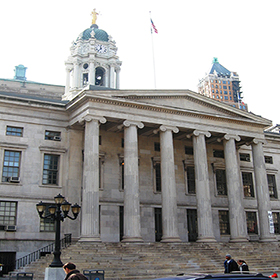
 Department of Citywide Administrative Services311
Department of Citywide Administrative Services311 Search all NYC.gov websites
Search all NYC.gov websites
Brooklyn Borough Hall

Brooklyn, NY 11209
Built: 1846-1851
Architect: Gamaliel King.
"…a dignified civic structure of impressive scale…"
-- NYC Landmarks Preservation Commission, in its 1966 designation decision.
Brooklyn Borough Hall, the original City Hall, is located on the north side of Joralemon Street, between Court and Adams streets. It houses the Brooklyn Borough President and is Brooklyn's oldest public building.
Brooklyn Borough Hall was originally built as Brooklyn's City Hall and contained the offices of the Mayor and the City Council as well as a courtroom and a jail. This was typical of early nineteenth century city halls, which contained all of the functions of city government within one building.
Brooklyn was a growing community when it was incorporated as a city in 1834. The following year a competition was held for a city hall, won by the architect Calvin Pollard. While the cornerstone for the Greek Revival style building was laid in 1836, only the foundation was built due to financial problems. Construction began again in 1845, with a revised and simplified design by Gamaliel King, and the incomplete City Hall opened in 1848. It served as the Brooklyn City Hall for nearly fifty years, before the consolidation with New York City in 1898, when it became the Brooklyn Borough Hall.
This imposing Greek Revival style structure is clad in Tuckahoe marble. A monumental staircase leads to an entrance with six fluted Ionic columns supporting a triangular pediment. The cast-iron cupola, designed by Vincent Griffith and Stoughton & Stoughton, is a 1898 replacement for the original, which burned in an 1895 fire that also destroyed part of the interior. The statue of Justice, part of the original plan, was finally installed on top of the cupola in 1988.
The architect, Gamaliel King, was a major figure in Brooklyn civic and ecclesiastical architecture in the 19th century. His practice began in the 1820s and he designed some of the borough's finest churches. His 12th Street Reformed Church (1868) in Park Slope still stands today. He designed the spectacular, domed King's County Courthouse (1861-5), now demolished, and the extant King's County Savings Bank (1868) in Williamsburg. He was well known for his pioneering commercial architecture in Manhattan through his work with John Kellum in the 1850s. The firm designed the landmark Cary Building in Tribeca, one of the first full-fronted cast iron buildings in the world.
The two-story rectangular lobby, known as the rotunda, has been restored to its 1845 glory. The stairs removed in 1897 were restored, as was the black and white marble floor. The elaborate Courtroom, designed in 1903 by Brooklyn architect Axel Hedman, has a coffered domed ceiling, carved wood paneling, fluted Ionic columns, and ornate plasterwork.
Brooklyn Borough Hall is one of the most significant government buildings in Brooklyn and the heart and soul of Brooklyn's Civic Center. In the 1980s, one of the City's most ambitious efforts to date was commenced to restore the exterior, which had suffered serious decay over the years. The award-winning work included stone work restoration, replacement of copper shingles on the cupola and installation of stainless steel cladding on the main roof, and repair of the clock and tower elements. The bronze statue of Virtue on the roof, a part of the original design not built with the building, was created from drawings and documents. Site work included raising the plaza by two feet, installing an ornamental iron fence around the building and placing historic lighting fixtures on the street.
Brooklyn Borough Hall is a designated New York City Landmark. It is also listed on the New York State and National Registers of Historic Places.


